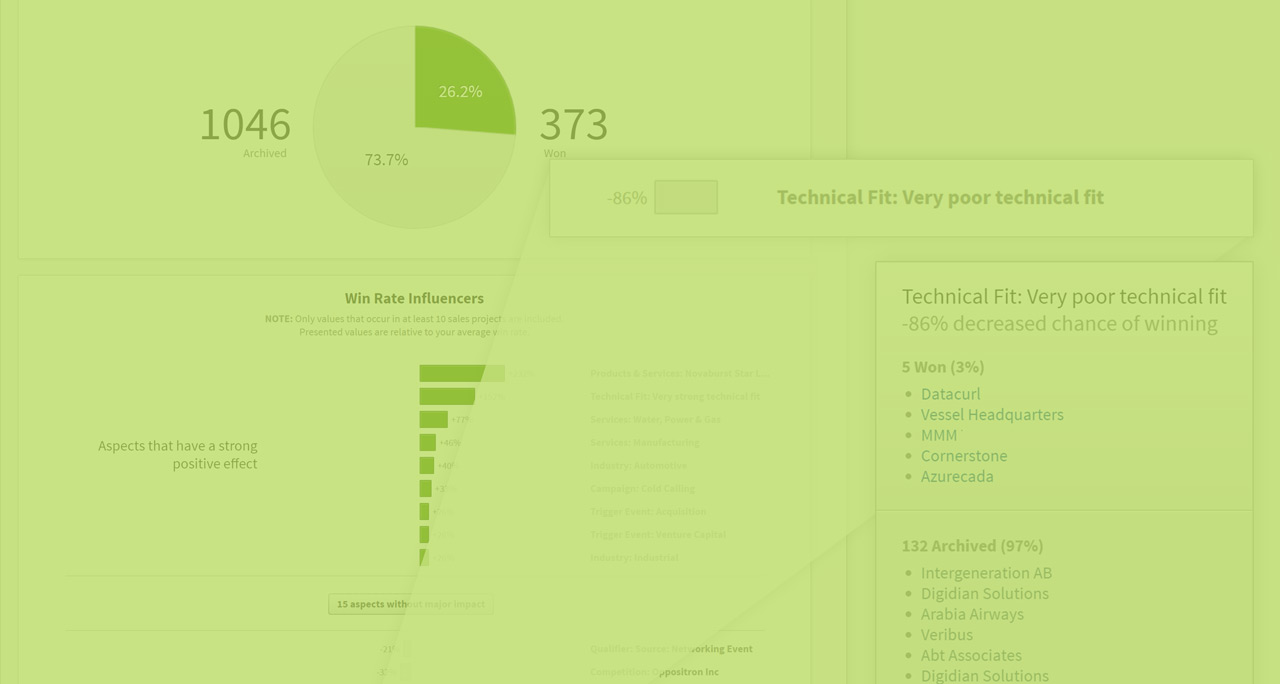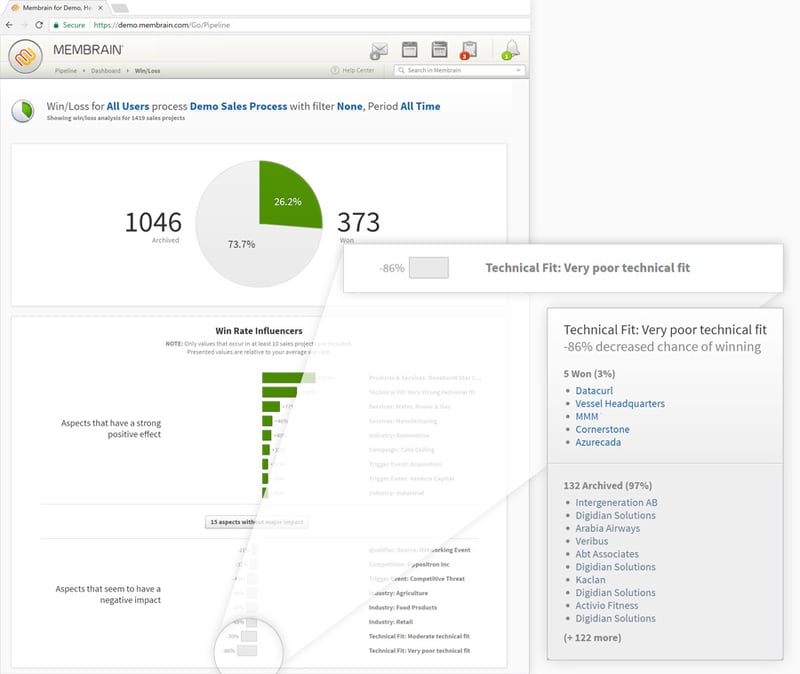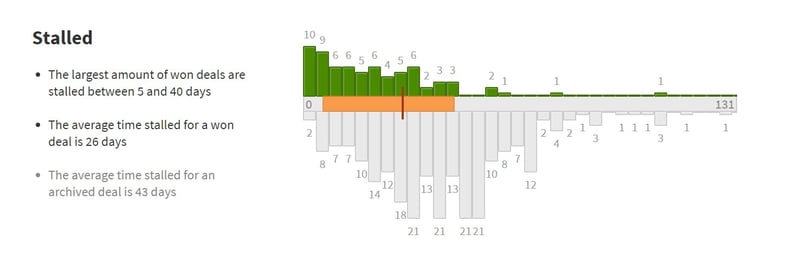
How to optimize sales effectiveness with Membrain
Many sales leaders remember when Salesforce hit the market in 1999 and created a buzz around how it was going to make sales more efficient and effective and increased pipeline visibility.
Next, “sales enablement” was the hot new topic in the industry, promising to change everything for the better and optimize sales performance. Over the years, we've seen social selling, marketing automation and several others being tagged the silver bullet for sales effectiveness. Today, the growing buzzword seems to be artificial intelligence.
Yet with all the technologies and buzzwords flying around, sales departments continue to struggle with the same old problems. And some of them are getting worse, as evidenced by the continual decline of sales effectiveness over the past nine years. The fact is, no new technology and certainly nothing so underdeveloped as AI, is going to rescue the sales industry all by itself. In fact, nothing is going to fix the effectiveness decline until we learn to identify what works and what doesn’t and how to get our sales teams doing the things that work.
Which brings us to what should be another popular industry buzzword: Optimization. Quite simply, optimization means identifying what works and doing more of that and less of what doesn’t, on a continual basis. It is also sometimes called “continual improvement,” and is often packaged with concepts like “agile development” or “lean process.”
For sales organizations, optimization means understanding which behaviors, activities, and process steps matter, identifying best and leading practices for each, and rolling out those behaviors, activities, and process steps across the organization so that every salesperson gets the benefit of the organization’s knowledge. It also means making sales forecasts increasingly accurate.
At Membrain, we talk a lot about sales process, coaching, and many other topics. But the heart of what we do is empower organizations to optimize their sales effectiveness.
Here’s how.
Step one: Collect process data
Most sales teams have only a very high level view of their sales process, if they’re using one at all. When we start with clients in Membrain, we work with them and their sales consultants to input their process into the software in such a manner that it will easy for the team to execute and collect useful data for later optimization.
Often, this starts simply with stages and milestones. For each stage and key milestones, we create rules that assigns a probability that an opportunity at that point in the process will become a sale. Most sales teams have only a vague idea about these probabilities, and that’s okay. Membrain’s unique optimization features allow us to guesstimate, and then fine-tune as we go.
By setting intelligent probability numbers at these stages and upon successfully completing key milestones, Membrain converts what is usually a subjective forecast into an evidence-driven one. Instead of relying on salespeople to tell the software how likely a sale is going to close, the system begins collecting quantitative data and assigning percentages automatically. Eventually, this creates a much more reliable pipeline forecast.
Step two: Analyze high-level data
When the new process has collected enough data points, Membrain’s sales analysis capabilities becomes a powerful tool for understanding what’s working and what is not. Using this analysis, users can view:
- Overall performance reports
- Performance by individual, team, service line, product line, industry, or any other factor about which data has been collected
- Quantitative forecasts based on the value of each opportunity times the win probability at its point in the process
- How the pipeline is spaced in time and stage
- Actual win rates against projected win rates
- Deal size and sales cycles against projections
- Overall accuracy of forecast against actual performance
Using this data, sales leaders can use tools within Membrain to quickly adjust percentages within the process to more accurately portray the actual pipeline and produce more precise forecast. They can also identify which individual team members, product lines, industries, and other factors are performing better and worse. This information can help determine where to invest resources and where to focus improvement efforts.
But let’s be honest here. At this point, you may be thinking that any CRM can be configured to provide this information.
Unfortunately that’s not even remotely true without significant (and costly) customizations.
What Membrain does better than anyone is making this information readily accessible with little to no setup beyond a checklist type of process implementation. With this in place everything the team does powers these powerful analytical capabilities. Membrain automatically captures and highlights insights and presents these as trend lines so you can see if, where and how the team as a group and individuals is developing. Sales leaders can then both optimize the process itself as well as the forecast accuracy.
Then, when we’ve already left the traditional CRM behind, let’s drill down to the next level.
Step three: Drill down into win/loss analysis
At the higher levels, Membrain’s analytics show whether you got your forecasts and probabilities right or wrong. At the win/loss level, you find out why.
You can see how opportunities move through the pipeline, and what percentages make it from one stage to the next. This allows you to adjust worst case / best case probability percentages within the stages to start to more accurately reflect reality.
But where Membrain’s optimization power really becomes evident is with the win rate influencers tool. This tool analyzes every single factor that you collect data on: The number of decision makers, the size of the deal, what competitors you’re up against, and even whether the salesperson asked a specific question at a specific point in the process. Then it sorts these factors based on their positive and negative influence on outcomes. The result is a chart showing which factors had the strongest influence on outcomes, for better and worse.
Within the win/loss screen, you can filter your view based on any data you have collected: Territories, industries, Product line, competitors, individual salespeople, specific client challenges, the number of decision makers, or the perceived reason for the outcome. Anything you can capture, can be analyzed to see its impact on win/loss, and is captured by the sales team simply executing your sales process.

In this example, the organization discovers from this analysis that technical fit is an extremely strong influencer on outcomes. If the technical fit is good, they win 65% of the opportunities. If the technical fit is poor, they win only 3%.
With this information, they can go back into the process and go deeper into technical fit questions earlier. In this way, the salesperson is enabled to focus more energy on opportunities more likely to close, and also enables them to “lose faster” when they’re going to lose anyway. It’s a simple example, but one that can have a tremendous effect on the your topline, and not many sales organizations do it.
Furthermore, the technical fit qualifier can be given a high percentage rating to reflect its influence on the outcome. This information then feeds into the forecast, providing a more accurate quantitative forecast.
Equally important, once you know what factors are most important, salespeople can be trained and coached on important techniques and skills, while allowing less important factors to be left out of the process.
For example, if reaching the CFO is a critical factor to success, then sales managers and leaders know to focus time and investment on teaching salespeople to reach these key stakeholders, and make a compelling case. If, on the other hand, the trigger event is not an important factor, that question can be removed from the process, thus streamlining and reducing administrative overhead for the salespeople.
Likewise, if you discover that a particular factor is a strong negative influencer, you can focus on overcoming that challenge. For instance, if a particular competitor performs strongly against you, you can discover why and invest in creating resources and/or improving the product to compete better.
Step four: Analyze pipeline data
Within the win/loss analysis tool, Membrain provides detailed data on pipeline momentum through a variety of metrics: opportunity aging, stage durations, progress and more. This particular visualization shows at which point a stalled deal becomes an issue and effectiveness drops off.

The green bars represent deals that were ultimately won, and the gray bars indicate the deals we were unable to win. The further to the right, the longer the time a deal stood still. In this example, we can clearly see the difference between the area that holds the bulk of won deals compared to the lost deals that we hold on to, with little chance of winning. We also see that very few deals are won when not seeing any progress through your sales process in 40 days.
Using this information, you can create an active pipeline with rules in the process that prompts salespeople and their managers to take action before opportunities are at risk of falling out of the process. You can also automatically remove deals from the pipeline that are beyond effective age, time in stage, or stalled time. This reduces the pipeline bloating that so many sales organizations struggle with, a key challenge in the way of an accurate forecast.
In the case of opportunities that spend too much time in a particular stage, the process can be improved to prompt the salesperson to return that opportunity to an earlier stage and begin again. In some cases, this can convert an unlikely prospect to a more likely one, and rejuvenate the opportunity.
Step five: Use the process editor to quickly optimize based on analysis
The process editor is where Membrain really shines against other available platforms. In most CRMs and other sales effectiveness platforms, making detailed changes to the sales process within the software requires careful planning, discussion, and expensive, lengthy technical involvement.
In Membrain, it’s as simple as click, type, and drop. For instance, consider that you’ve now discovered that technical fit is a critically important factor and you want salespeople to begin asking those questions earlier in the process. Using Membrain’s intuitive interface, you can simply add it as an activity, identify it as a qualifier, assign it a percentage, input its role in opportunity scoring, and drag it to the point in the process when you want salespeople to perform the activity.

Accompanied by training and coaching, this creates almost instant improvement in sales performance. If you later find out that the change was a mistake–for instance, if salespeople say they can’t possibly find out information about technical fit that early in the process–it’s equally simple to drag the step to a later point in the process or to tweak it to make it more effective.
Each such change takes less than a minute, with no technical involvement. Depending on how your system is set up, the changes can be applied instantaneously across the organization, the department, or just on a single sales team.
Likewise, percentage values can be changed, as can scoring percentages and other factors, at the click of a few buttons. Timing of warnings and automatic actions can be changed as well. Sales enablement, training, and other content can be associated with each activity as well to improve your team’s ability to perform the behaviors required. As one of our clients put it to his sales operations team: “I want you to forget the phrase 'locked in', because that doesn’t exist in Membrain.”
Having made these changes, you click “save” and “publish,” and you’ve already got a better forecast and more effective sales process than you did 60 seconds before.
Step six: Adjust and improve
The longer you use Membrain, the more data you have about what works and what doesn’t. As you identify which factors matter, you can drill down into them and improve them further. You can add factors to measure, thus discovering more of what matters and what doesn’t. If one thing doesn’t work, you can quickly and easily replace it with another.
Because you can make these changes at the process, stage, milestone, step, and even individual salesperson behavior level, you can use Membrain to continually improve process, methodology, and individual salesperson skills.
For instance, let’s say you discover that speaking with the CFO significantly improves outcomes. You discover that some salespeople are better at reaching and communicating with the CFO than others. You can interview or shadow your high performers on this factor to learn what they’re doing that’s different. You can then build those behaviors into your methodology training as well as into process activities within Membrain.
Step seven: Lather, rinse, repeat
When used in this way, Membrain allows sales teams of any size to continually improve their process, methodology, and behaviors to meet the unique needs of their particular market. Most of our clients find the ease and effectiveness of Membrain’s continual improvement function to be addictive. Certainly, optimization is most effective when it is applied repeatedly. In this environment, instead of a constant churn and struggle to meet quotas, sales teams find that they become continually more and more effective, often outstripping their competition and consistently outstripping their own previous performance.
Membrain can stand alone as a CRM and sales effectiveness platform, or it can plug directly into your existing CRM to supercharge it with all of Membrain’s plug-and-go optimization functionality. If you’d like a customized demonstration of how Membrain can help your team optimize its effectiveness, contact us today.

By Henrik Öquist
Co-CEO & Chief Product Officer for Membrain. Dedicated to giving sales people better tools and improve B2B sales effectiveness, Henrik has helped hundreds of companies from start-ups to large enterprises develop and operationalize sales processes and to use technology to make it easier to successfully execute their sales strategy.
Find out more about Henrik Öquist on LinkedIn








